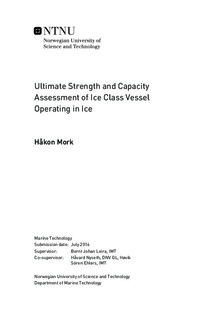Ultimate Strength and Capacity Assessment of Ice Class Vessel Operating in Ice
Master thesis
Permanent lenke
http://hdl.handle.net/11250/2403630Utgivelsesdato
2016Metadata
Vis full innførselSamlinger
- Institutt for marin teknikk [3397]
Sammendrag
In an ongoing project between DNV GL and a customer, the ultimate strength anddamage on a ship exposed to ice loading are to be assessed. The vessel has the DNVGL class notation Ice(1A*), but is now considered for operation in more severe iceconditions than it initially was designed for. The purpose of the thesis is to analyzethe response of a hull model subjected to different loads and to determine the residualcapacities after first yield. Ice properties and numerical models will also be reviewed.
Ice as a material is complex because its properties are strongly dependent on parameterssuch as strain, strain rate, porosity, salinity, crystal structure and stress-state.Moreover, the load distribution exerted by ice on impacting structures is highly irregulardue to brittle failure, including fracturing, crushing and spalling. These propertiesmake ice diffcult to model. The developed numerical models all have their flaws and there are currently no "verifed" material models for ice, despite decadesof research. The main issue seems to be their ability to reproduce the irregular loaddistributions.
Class rules use a simplied approach where it is assumed that all energy will bedissipated by the ice, implying crushing of ice. When exceeding design load level,the hull will start to deform plastically and the residual capacity will be utilized.Ice class vessels are actually expected to experience loads somewhat larger than thedesign loads, and some deformation is accepted. The rules do, however, only have asingle design point at first yield and there are no further requirements on the residualstrength of the hull.
A finite element model of a part of the bow was considered. Rectangular, uniformpressure patches of different sizes were applied at different locations of the model.Linear response analyses were executed and the capacity with respect to first yieldwas determined. The highest stress levels occurred in the stiffeners, and loads centeredthe farthest away from the bulkheads were found to be the most critical. Linearcapacities ranged between 1.3 MPa and 3.7 MPa. It was also found that the ruledesign loads are similar to the rst yield capacities calculated.
The residual capacities were determined by doing nonlinear finite element analyses.A user defined ultimate strength criterion based on maximum allowable permanentdeformations was made. Permanent lateral deformation at stiffener midspan of 0.5% or 1.0 % of the stiffener length was set as a criterion. The idea was to allowdeformations that can be regarded as acceptable, and the strain levels were foundto be well below material capacity using these criteria. The hull showed to exhibitultimate strengths in the range of 1.5 to 3.6 times the linear capacity, dependingon the load distribution. Two boundary conditions were considered, and they gaveequal results.
Even though the hull exhibits large residual capacities after first yield, it is questionedwhether this alone can be used as leverage for allowing the vessel to operate in moresevere ice conditions than it was designed for. Ice loads larger than design loads areexpected in the first place, so some of this residual strength is taken into account bythe class notations. Numerous damages on ice class vessels have been reported, so it is clear that the simplified method used in class notations has its weaknesses.
For future work it is recommended to do analyses with nonuniform pressure patches,which is more realistic and more conservative. Doing long-term full scale measurementsis also recommended. A distribution function can be fit to the the measuredloads and from this a new design load can be determined using a probabilistic approach.Using the capacities calculated in this thesis, it can be determined whetherthe vessel can operate in harsher ice conditions than it was initially designed for ornot.
